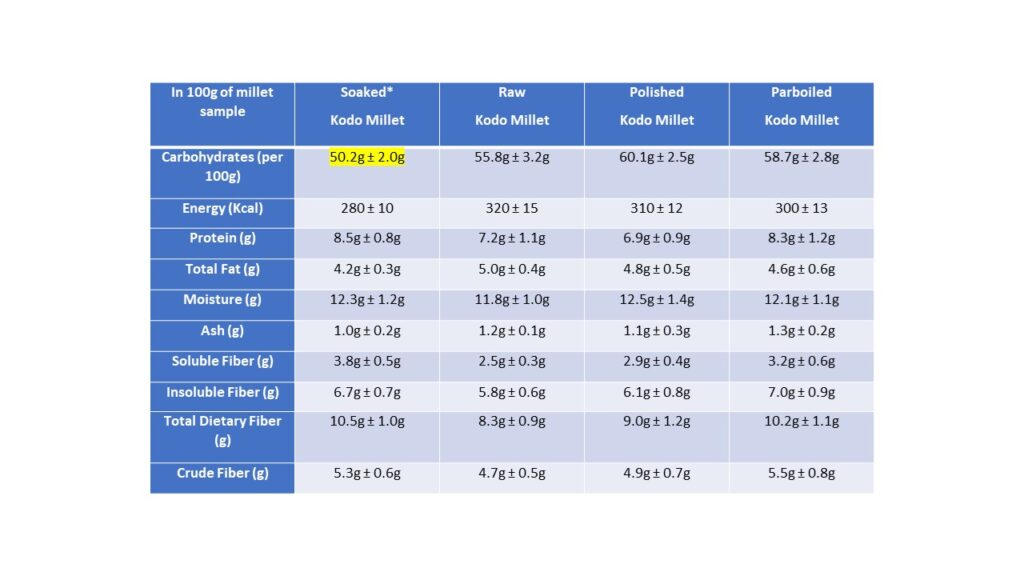Uncategorised
Are You Obtaining Both High-Quality and Sufficient Quantities of Carbohydrates from Your Millets?
With an experimental study on Kodo millet

We are a carbohydrate-eating community, and understanding the carbohydrate content and quality helps us make informed choices about our diet. It’s about being mindful of the types and amounts of carbohydrates consumed for better blood sugar control and overall well-being.
Now, diving into glycemic load (GL) and glycemic index (GI) – two crucial factors. Picture your body as a car, and the food as fuel. GI is like a traffic light, indicating how fast carbs convert into blood sugar.
Low GI (green light): Slow sugar release, found in whole grains and veggies, (55 or less): Rated as low.
Medium GI (yellow light): Moderate release, in fruits and polished grains, (56-69): In the middle.
High GI (red light): Quick energy boost, but short-lived, like polished and processed foods, sugary snacks, (70 or more): Rated as high.
Adding another layer: glycemic load (GL). If GI is fuel type, GL is the amount. It considers both carb quality and quantity.
Low GL: Small carb amount, minimal blood sugar spike.
High GL: Larger carb amount, significant blood sugar increase.
Choosing the right fuel (type and amount) keeps your body’s engine running smoothly.
GL scale: High (20 or more), medium (11-19), and low (10 and under).
Factors affecting GI include cooking methods, processing levels, and fat content.
Let’s consider the example of millet, and explore how factors such as cooking methods, processing levels, and fat content can affect its Glycemic Index (GI).
Cooking Methods:
Boiled Millet (Low GI): Cooking millet by boiling it in water generally results in a lower GI compared to other methods. Boiling helps maintain the grain’s structural integrity and prevents it from rapidly breaking down, leading to a slower rise in blood sugar levels.
Millet Flour (Higher GI): On the other hand, processing millet into flour that increases its surface area, which can lead to quicker digestion and absorption, potentially elevating the GI.
Processing Levels:
Whole Millet (Lower GI): Consuming millet in its whole form, with minimal processing, tends to result in a lower GI. Whole grains usually have a slower impact on blood sugar levels due to their intact fiber structure. This doesn’t apply for polished or parboiled millets.
Sprouting, Fermenting (Low GI): Activates the enzymatic activity and results in more fibre as well.
Fat Content:
Millet with Added Healthy Fats (Lower GI): Including healthy fats, such as oil or nuts, when cooking millet can help lower its GI. Fats slow down the digestion and absorption of carbohydrates, resulting in a more gradual increase in blood sugar levels.
In summary, cooking methods, processing levels, and fat content can all influence the Glycemic Index of millet. Choosing cooking and processing methods that retain the millet’s whole form and incorporating healthy fats can contribute to a lower GI and better blood sugar control.
While GI and GL are useful for understanding blood sugar level spikes considering the factors like fat and fiber content, food processing, and cooking methods. Studies suggest that lower glycemic foods may delay hunger and decrease subsequent food intake.
Let’s, see how Glycemic Index (GI) and Glycemic Load (GL) are two important concepts that can be elucidated in the context of obtaining high-quality and sufficient quantities of carbohydrates from millets..
In the course of documenting the nutritional and biochemical profiles of various processing methods of Kodo Millet, a captivating revelation came to light: the carbohydrates in soaked millet undergo a subtle transformation. This discovery spurred me to delve deeper into understanding both the quantity and quality of these carbs.
Breaking down the evaluation of Carbohydrates in Soaked Kodo Millet:
Carb Quantity: Soaked Kodo Millet showcases a noteworthy reduction in carbohydrates per 100g compared to its raw, polished, and parboiled counterparts. This characteristic makes it ideal for those managing blood sugar levels and seeking controlled carbohydrate intake.
Carb Quality Enhancement: The soaking process not only reduces antinutrients but also elevates the overall nutritional quality of Millet.
Glycemic Response Impact: The synergy of reduced carbohydrates and improved quality in Soaked Kodo Millet may contribute to a lower glycemic index (GI) and glycemic load (GL). This property ensures a gradual release of glucose, crucial for diabetes management and sustained energy.
Dietary Fiber Boost: Soaked Kodo Millet reveals a substantial increase in both soluble and insoluble fiber. This boost promotes digestive health, creates a feeling of fullness.

*Soaked here specifically refers to the unique processing carried out at Goodness Farm to reduce the antinutrients.
This numerical data showcases the nutritional profile of soaked Kodo millet, emphasizing its potential as a low-GI and low-GL option indicating a slower and more controlled impact on blood sugar levels compared to raw, polished, and unpolished counterparts.
The scientific reason behind changes in carbohydrates, can be attributed to the process of soaking and its impact on the millet’s composition. Here are several key factors:
Reduction in Antinutrients:
Soaking is an effective method for reducing antinutrients present in millets. Antinutrients, such as phytic acid, are compounds that can bind minerals, reducing their bioavailability. By soaking millets, these antinutrients are often partially or completely broken down, allowing for better absorption of essential minerals and nutrients.
Enzymatic Activity:
Soaking activates enzymes naturally present in millets. Enzymes, such as amylase, can break down complex carbohydrates into simpler sugars. This enzymatic activity contributes to the breakdown of starches in millets, potentially leading to a decrease in overall carbohydrate content.
Hydration and Water Absorption:
Soaking involves the absorption of water by the millet grains. This hydration process can lead to changes in the physical structure of the grains, causing them to swell. As a result, the overall volume occupied by the soaked millets may increase, but the concentration of carbohydrates per unit weight may decrease.
Leaching of Soluble Sugars:
During soaking, some soluble sugars in millets may leach into the soaking water. This leaching process can contribute to a reduction in the carbohydrate content of the millet. However, it’s essential to note that the extent of sugar leaching may vary depending on the type of millet and the specific soaking conditions.
These processes collectively contribute to the observed differences in carbohydrate composition between soaked millets and their raw, polished, parboiled and unpolished counterparts.
To conclude, Soaked Millet emerges not only as a reduced-carbohydrate option but also as a product enriched in carbohydrate quality.
Now, let’s journey to Goodness Farm, where the grains undergo a distinctive conscious processing by triple soaking. The goal is to enhance nutrient absorption and establish a more balanced macronutrient profile.
Maria Jenita, PhD
Food Technologist
